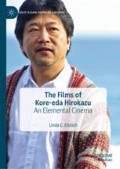Abstract
In the concluding chapter of The Films of Kore-eda Hirokazu: An Elemental Cinema, the author discusses some of the overarching themes examined in the book: trauma and survivor’s guilt, the nature of families (childhoods, parenting), changing notions of masculinity, various forms of play in the films, and a reexamination of the roles of the natural elements.
Access this chapter
Tax calculation will be finalised at checkout
Purchases are for personal use only
Bibliography
Addis, Stephen, Gerald Groemer, and J. Thomas Rimer, ed. Traditional Japanese Arts and Culture: An Illustrated Sourcebook. Honolulu: University of Hawaii Press, 2006.
Anderson, Jason. “The Third Murder” (review). Sight and Sound, 2017, 52–53.
Aoyama Tomoko, Laura Dale, and Romit Dasgupta, ed. Configurations of Family in Contemporary Japan. Nissan Institute/Routledge Japanese Studies, 2014.
Bradshaw, Peter. “Hirokazu Kore-eda: They Compare Me to Ozu…But I’m More Like Ken Loach.” The Guardian, 2015.
Chang, Justin. “A Quiet Mastery of Cinema: Japanese Director Hirokazu Kore-eda Is Being Honored with a Career Retrospective.” Los Angeles Times, October 25, 2017, E1.
Dargis, Manohla. “A Family that Steals Together, Stays Together.” New York Times, November 22, 2018.
———. “In The Third Murder, Guilty as Charged Isn’t the Whole Story.” New York Times, July 18, 2018.
Echart, Pablo, and Miguel Muñoz-Garnica. “Infancia y desestructuración familiar en el cine de Hirokazu Koreeda: Nadie Sabe, Milagro, y De tal Padre, Tal Hijo.” Fotocinema: Revista científica de cine y fotografía 14 (2017): 313–339.
Ellis, Jonathan. “After Life,” Film Quarterly 57, no. 1 (2003): 36.
Elsaesser, Thomas. “Touch and Gesture: On the Borders of Intimacy.” Framework: The Journal of Cinema and Media 60, no. 1 (Spring 2019): 9–25.
Gang Dong-won. “Eizō no terre.” Kore-eda Hirokazu: Mata Koko kara Hajimaru (special issue). Kawade Yume Mukku, 2017.
Gerow, Aaron. Tangemania (BLOG) “Koreeda Hirokazu at Yale, Day 1.”
Gondry, Michel. “Kore-eda no eiga wa: boku no tomodachi.” In Kore-eda Hirokazu: Mata Koko kara Hajimaru (special issue). Kawade Yume Mukku, 2017.
Gordon, Andrew. A Modern History of Japan: From Tokugawa Times to the Present. New York: Oxford University Press, 2014.
Goto Miyabi. “Shoplifters” (review). The Popular Culture Studies Journal 7, no. 1 (2019): 218–220.
Guth, Christine, ed. Asobi: Play in the Arts of Japan (Katonah Art Museum), 1992.
Iles, Tim. “The Light of Life and Death—The Function of Cinematography and Lighting in Two Films by Kore-eda Hirokazu.” Asian Cinema (2005): 205–219.
Jacoby, Alexander. A Critical Handbook of Japanese Film Directors: From the Silent Era to the Present Day. Berkeley: Stone Bridge Press, 2008.
———. “The Interview: Koreeda Hirokazu.” Sight and Sound 29, no. 5 (May 2019): 46–49.
Jenkin, David. Nobody Knows. In Of Flesh and Blood: The Cinema of Hirokazu Koreeda, 44–49. British Film Institute, 2019.
Johnson, William. “Hirokazu Kore-eda.” Film Comment 35, no. 4 (July–August 1999): 64–67.
Kore-eda Hirokazu: Mata Koko kara Hajimaru (special issue). Kawade Yume Mukku, 2017.
Kore-eda Hirokazu. “‘Invisible’ to iu kotoba o megutte.” June 5, 2018. http://www.kore-eda.com/message/20180605.html.
———. “Shukui ni kanshite.” June 7, 2018.
Leader, Michael. “Still Walking Q &A. BFI Southbank.” In Of Flesh and Blood: The Cinema of Hirokazu Koreeda (disc four), April 16, 2019.
Lopate, Phillip. “Found Families.” New York Review of Books, January 17, 2019, 36–37.
Miranda, Luis. The Catalogue of 8 Festival Internacional de Cine/Las Palmas de Gran Canaria, 2007.
Miyamoto Teru. Phantom Lights and Other Stories [Maborosi no hikari]. Translated by Roger K. Thomas. Fukuoka: Kurodahan Press, 2011.
Moreno, Nieves. “Elogio de la memoria: Kore-eda Hirokazu/In Praise of Memory.” Secuencias: Revista de Historia del Cine 30 (UAM, Ocho y Medio) (2009): 80–93.
Morrison, Susan. “Distance: Hirokazu Kore-eda.” Cineaction 57 (March 2002): 58–59.
Park, Je Cheol. “Envisioning a Community of Survivors in Distance and Air Doll.” Film Criticism XXXV (2–3) (Special double issue: Kore-eda Hirokazu), edited by Arthur Nolletti, Jr., 166–186.
Risker, Paul. “Questioning the Nature of Family Bonds.” Cineaste XLIV, no. 2 (Spring 2019): 42–43.
Ronald, Richard, and Allison Alexy, ed. Home and Family in Japan: Continuity and Transformation. London: Routledge, 2011.
Satō, Hiroaki, and Burton Watson, ed. From the Country of Eight Islands: An Anthology of Japanese Poetry. New York: Anchor Books, 1981.
Sharp, Jasper. “The Hidden Heart in the Home Dramas of Hirokazu Korereda.” Of Flesh and Blood: The Cinema of Hirokazu Koreeda, British Film Institute, 53–59. British Film Institute, 2019.
Spirn, Anne Winston. The Language of Landscape. New Haven: Yale University Press, 1998.
Tarkovsky, Andrey. “Between Two Films” cited in the Criterion DVD package of Ivan’s Childhood, 21. Originally it appeared in Iskusstvo kino journal in 1962. English translation by Professor Robert Bird.
Tsuji Nobuo. Playfulness in Japanese Art (Franklin D. Murphy Lectures VII). Spencer Museum of Art. University of Kansas, 1986.
Wood, Robin. “Images of Childhood.” In Personal Views: Explorations in Film, 189–212. Detroit: Wayne State University Press, 2006.
Author information
Authors and Affiliations
Rights and permissions
Copyright information
© 2019 The Author(s)
About this chapter
Cite this chapter
Ehrlich, L.C. (2019). Final Thoughts. In: The Films of Kore-eda Hirokazu. East Asian Popular Culture. Palgrave Macmillan, Cham. https://doi.org/10.1007/978-3-030-33051-4_17
Download citation
DOI: https://doi.org/10.1007/978-3-030-33051-4_17
Published:
Publisher Name: Palgrave Macmillan, Cham
Print ISBN: 978-3-030-33050-7
Online ISBN: 978-3-030-33051-4
eBook Packages: Literature, Cultural and Media StudiesLiterature, Cultural and Media Studies (R0)

